Thai silk
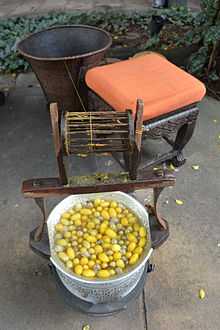
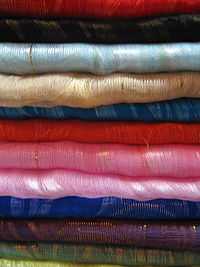
Thai silk is produced from the cocoons of Thai silkworms. Thai weavers, mainly from the Khorat Plateau in the northeast region of Thailand, raise the caterpillars on a steady diet of mulberry leaves. Khorat is the center of the silk industry in Thailand and a steady supplier of rose Thai silk for many generations.[1]
Today, Thai silk is famous for its special qualities produced through unparalleled manufacturing processes, bearing unique patterns and colors.
Origin

After silk originated in ancient China and India where the practice of weaving silk began around 2,640 BCE, Chinese merchants spread the use of silk to different regions throughout Asia through trade. Some accounts indicate that archaeologists found the first fibers of silk in Thailand to be over 3,000 years old in the ruins of Baan Chiang, the site is considered by many to be Southeast Asia's oldest civilization.[2]
However, the silk produced on the Khorat plateau was generally only used for private consumption, with the Thai court preferring to purchase Chinese silk imports. There was an attempt in the early twentieth century to develop the industry, with the help of a Japanese sericulture expert, Kametaro Toyama. But these attempts failed due to a lack of interest locally to produce for a larger market.[3]
However, after World War II, an American OSS officer called Jim Thompson decided that silk would be popular back at home in America and through his connections in New York began marketing the product as a traditional Siamese material. In fact, the material he created had little relationship to what had previously been produced in the country. But through clever branding and by developing a range of 'Thai' patterns, he managed to establish Thai Silk as a recognizable brand.[4]
Writing in the Bangkok Post in 1949, Alexander MacDonald described that 'out of a number of scattered remains of history, from cultures borrowed from Siam's neighbors, and from colonies of fat and lazy Siamese silk worms, Jim Thompson is trying to build a modest business.'[5] Throughout the 1950s Thais remained little interested in Thai Silk, considering it generally suitable only for fancy dress.
Weaving
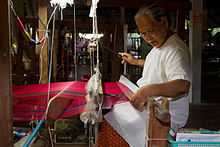
The production of Thai silk begins with the Bombyx mori, a small silk worm that comes from the eggs of a silk moth. For their first year, these worms feast on the leaves of mulberry trees before building a cocoon from their spittle.
In its original cocoon form, raw silk is bumpy and irregular. Thai weavers separate the completed cocoons from the mulberry bush and soak them in a vat of boiling water to separate the silk thread from the caterpillar inside the cocoon.
The Bombyx mori usually produces silk thread of varying colors, ranging from light gold to very light green, with lengths varying from 500 to 1,500 yards per cocoon.
A single thread filament is too thin to use on its own so Thai women combine many threads to produce a thicker, usable fiber. They do this by hand-reeling the threads onto a wooden spindle to produce a uniform strand of raw silk. The process is a tedious one as it takes nearly 40 hours to produce a half kilogram of Thai silk.
Many local operations use a reeling machine for this task, but the majority of most silk thread is still hand-reeled. The difference is that hand-reeled threads produce three grades of silk: two fine grades that are ideal for lightweight fabrics and a thick grade for heavier material.
The silk fabric is then soaked in hot water and bleached before dyeing in order to remove the natural yellow coloring of Thai silk yarn. To do this, skeins of silk thread are immersed in large tubs of hydrogen peroxide. Once washed and dried, the silk is then woven using a traditional hand operated loom.[6]
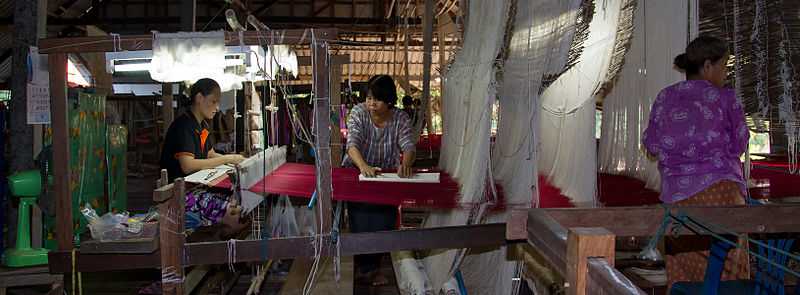
Identification
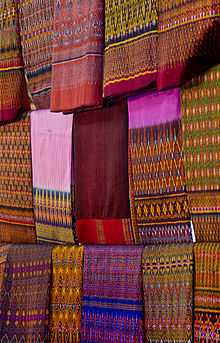
Since traditional Thai silk is hand woven, each silk fabric is unique and cannot be duplicated through commercial means. In contrast, artificial silk is machine woven, which means that every part of the fabric is identical and has the same color.
In addition, Thai silk has a unique lustre, with a sheen that has two unique blends: one color for the warp and another for the weft. Color changes as you hold the Thai silk fabric at varying angles against light.
Moreover, Thai silk smells like hair when burned, a testament to the natural fibre that comes from the silk worm, which is similar to the fibre of human hair and fingernails. If you move the flame, Thai silk immediately stops burning. On the other hand, artificial silk smells like plastic when burned.
In terms of price, Thai silk is usually 10 times more expensive than artificial silk.
Another simple way to identify authentic Thai silk is the "wedding ring" test.[7]
Gallery
See also
- Jim Thompson, an American businessman who helped revitalize the Thai silk industry in the 1950s and 1960s.
References
- ↑ About Thai silk
- ↑ Who discovered silk from World of Thai Silk (commercial)
- ↑ Ian Brown, ‘Government Initiative and Peasant Response in the Siamese Silk Industry, 1901 - 1913’, Journal of the Siam Society, Vol. 68, Part 2, July 1980, 34
- ↑ Joshua Kurlantzick, The Ideal Man: The tragedy of Jim Thompson and the American Way of War (Wiley, 2011)
- ↑ The Postman Says, Bangkok Post, January 13 1949
- ↑ About Thai silk from World of Thai Silk (commercial)
- ↑ http://www.thaisilkmagic.com/genuinethaisilk.php
Types
To be able to identify genuine Thai silk easily, Thailand's Agriculture Ministry uses a peacock emblem to authenticate Thai silk and protect it from imitations. The peacock emblem serves as a guarantee of quality and it comes in four different colors based on specific silk types and production process.<ref>[http://www.thailandfashion.net/index.php?id=1604 Queen bestows quality emblem for Thai silk]</ref> These are the following:- Gold peacock: Indicates the premium Royal Thai Silk, a product of native Thai silkworm breeds and traditional hand-made production.
- Silver peacock: Indicates Classic Thai Silk, developed from specific silkworm breeds and hand-made production.
- Blue peacock: Indicates Thai Silk, a product of pure silk threads and with no specific production method (allows chemical dyes).
- Green peacock: Indicates Thai Silk Blend, a product of silk blended with other fabrics and with no specific production method.
Exports
In 2006, $14,540,325 worth of silk was exported from Thailand. The predominant markets are the U.S., and the U.K.<ref>[http://www.geospace.co.uk/silk/thailand_silk_exports.html Exports of silk from Thailand]</ref> Silk fabric accounts for about half of the silk exported from Thailand (the rest being raw silk, yarn, cocoons, and silk waste). However, Thai producers remain only a small contributor to the global trade in silk.<ref>The global trade in silk
| ||||||||||||||||||||||||||||||||||||
| ||||||||||||||||||






